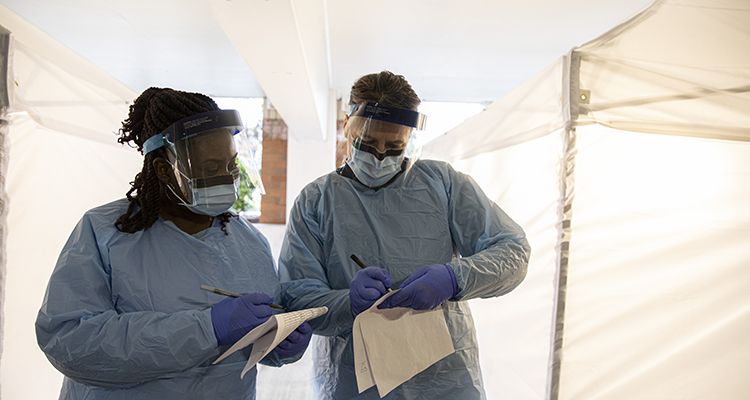UW Medicine researchers used the power of cloud computing to speed the response to COVID-19 in vulnerable populations, and their methods could be used to tackle other disasters.

By Ignacio Lobos
As the COVID-19 pandemic spread across the Northwest last year, a group of UW medical experts saw a major opportunity to gain an edge against the disease.
Buried among millions of clinical and non-clinical patient records from patients treated or tested for COVID-19 at multiple UW Medicine facilities was a trail of electronic data, the researchers believed, that could lead to better health care decisions and show how the pandemic was spreading within populations, and particularly in those most vulnerable to the disease.
It was a massive — and ever growing — data set. Consider that as 2021 was ending, the UW Medicine electronic health record included more than 4 million patient tests conducted by UW Virology Division in UW Medicine’s Department of Laboratory Medicine. These zeroes and ones stored securely in UW computing facilities sure had stories to tell.
But making sense of large patient data sets in real time is a major challenge, said Jim Phuong, a research data scientist with UW Medicine IT Services and a member of a UW Medicine cross-disciplinary team that used machine learning and the power of cloud computing on the UW Medicine electronic health record to learn from their COVID-19 response.
“The COVID-19 pandemic forced us to think in new ways about how to gain meaningful insight about these types of disasters and use that information to help us make better choices, from where to direct research to how to allocate finite resources and care for vulnerable populations,” Phuong said.
Data crunching reveals economic factors at play
Last April, Phuong and colleagues from the departments of Epidemiology, Anesthesiology, Biomedical Informatics and Medical Education, and Epidemiology got a chance to test their hypotheses. They received funding from the Population Health Initiative’s COVID-19 rapid response grants program.
The team quickly gathered data from a smaller and more manageable pool of about 67,000 patients living in King County, Washington, home to the UW and three of the state’s largest cities.

Research Data Scientist, UW Medicine Information Technology
As part of their study, patient data was transferred securely to a cloud computing environment by Phuong and team members after they removed personal identifiers. Then, researchers used machine learning models to identify traits for who in a given population was more likely to test positive for COVID-19 and how different risk factors contribute to explain the changing COVID positivity rate among UW patients.
This information could be used by medical experts to make more informed clinical decisions, Phuong said, such as how to allocate limited resources across departments, including diagnostic tests, intensive care unit beds and personal protection equipment.
Patient data also was coupled with other publicly available data, such as addresses, allowing the team to identify geographic regions at greater risk of community outbreak within King County, Phuong said.

By August, they had some answers, confirming that geographic, demographic and socioeconomic factors were strong predictors of COVID-19 positivity.
In other words, Phuong said, people who lived in lower-income areas had a higher likelihood of testing positive for COVID-19 during the first six months of the pandemic than those who lived in high-income areas.
The study showed the value of coupling clinical patient data to other data sets, which could improve the deployment of testing, outreach to at-risk populations and better overall prevention efforts, Phuong said.
Leveraging the public cloud for medical research
For Rob Fatland, research computing director for UW-IT, the electronic health record project was a perfect example of what cloud computing can do for researchers.
Cloud computing is also known as the public cloud, which refers to any on-demand computing infrastructure provided and managed by a third-party provider (such as Microsoft’s Azure or Amazon Web Services) and accessible via the Internet. Multiple users and organizations, including major universities, use the public cloud.

Research Computing Director, UW Information Technology
Fatland, a tireless proponent of using the cloud for research, said the resource remains a vastly underutilized tool even now among academics. There are many reasons for that, he said. Not all researchers have computing training and the starting point for cloud computing may seem daunting. Others worry about whether their data will be protected and accessible only to those who are given permission to use it.
But Fatland is gaining traction, getting more researchers to consider cloud computing for their work. And that’s because others are paying attention to critical, timely research, such as the research done by Phuong and others in UW Medicine using a secure cloud computing environment, and that they likely couldn’t have done it without the security and capabilities that the cloud provided.
“A really important aspect of Jim’s project is that it can be a ground breaker for more secure clinical studies on the cloud,” Fatland said. “Their project is showing that it’s possible to migrate millions of patient records safely into the cloud to allow multiple vetted researchers to work with that data.”
In fact, building a HIPAA-compliant digital research environment was a major goal of the group’s project, Phuong said. HIPAA stands for the Health Insurance Portability and Accountability Act of 1996, which are standards for the electronic exchange, privacy and security of health information.
Part of their work was built on an earlier UW Medicine blood pressure study with HIPAA-protected data, which was successfully transferred to a cloud environment. In that project, Phuong ensured that patient data was stored securely and accessible to project researchers.
With The COVID-19 study, the security of patient data also was a top priority.
“Cloud computing can be a daunting proposition for some researchers,” Phuong said. “For me, this project was an opportunity to show proof of concept, to give my colleagues the tools they need to gather data quickly, have a way to analyze it, and work with fellow researchers to advance their research.”
To make it happen, Phuong and fellow team members created a secure computing environment, with firewalls and stringent identity protocols. A scope of the work required UW researchers to maintain control of their workspaces so they could grant and manage access to data when partnering with external collaborators.
“A secure environment for research collaboration can unlock data that makes us better at responding when disaster strikes,” he said.
The project also helped the team select the appropriate digital tools, such as software, best suited to this type of medical research.
“We need to understand how researchers use data and tools, and how it serves them,” Phuong said. “From the software they need to access the cloud environment, to how we map and architect the information so researchers can find what they need.”
It’s not just about COVID
UW’s research on population health, climate change and environmental disasters is world-renowned, Phuong said. And because he has been deeply involved in some of these other areas as he worked on his PhD at the UW, he sees great potential from this COVID-19 pilot.
How we deal with disasters such as fires, hurricanes and floods — and their aftermath — on populations is a large and urgent area of study. Last summer, Phuong remembered looking up into the sky when massive fires across the Northwest blanketed Seattle and the region in a thick cloud of smoke.
Nature is unpredictable that way. One day the air is fine, then the next it’s not. Air currents moving at their own pace can carry toxic particles from hundreds of miles away, with the potential to wreak havoc on the respiratory systems of millions of people.
That has been true during the pandemic, another phantom menace moving through the air, causing havoc wherever it landed, Phuong said.
“Whether you’re studying earthquakes, hurricanes, floods or airborne diseases such as COVID-19, we can collect data that can help us make better decisions about people’s health and who is more vulnerable,” he said. But first, you must unlock the data.
